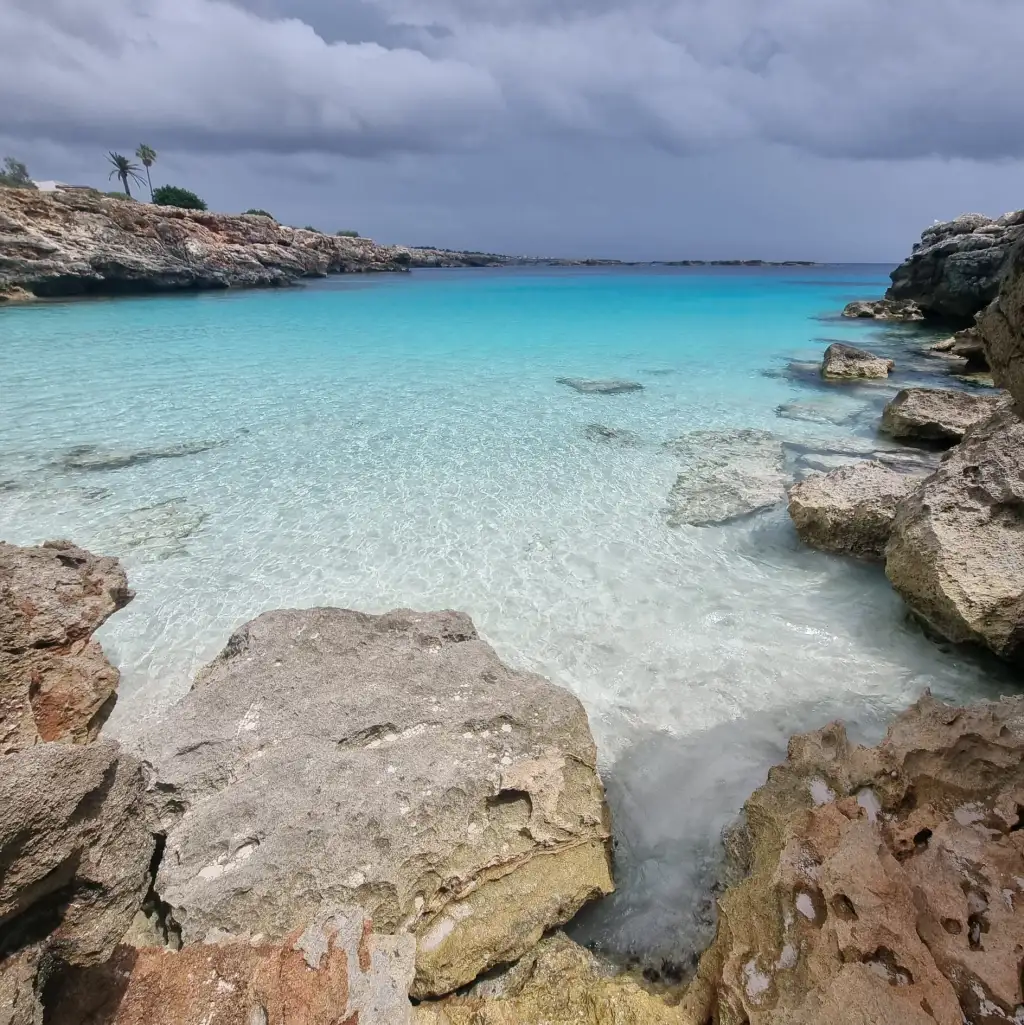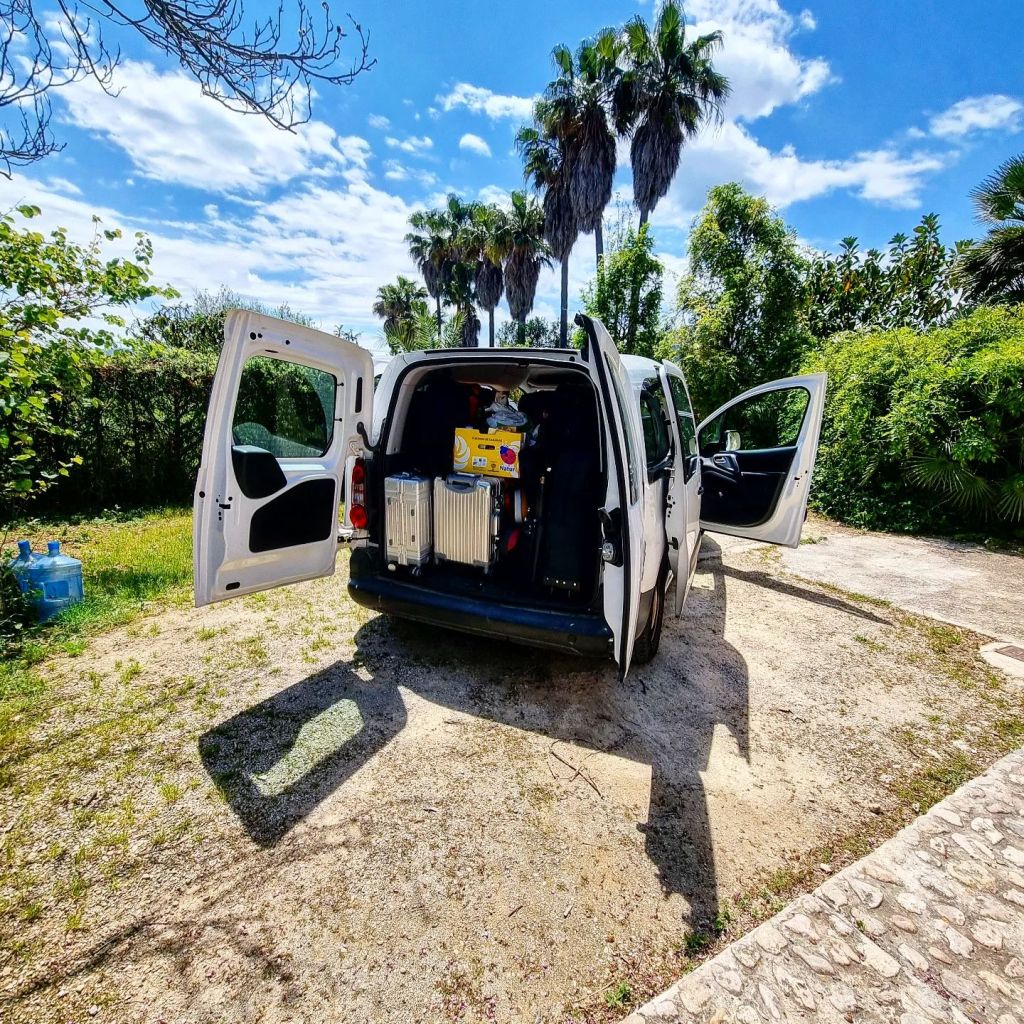[ 22:55 Friday 1 July 2022 – Los Escullos, Andalucia ]
One year ago today, Alejandro and I tumbled out of the airport in Palma with an avalanche of suitcases, bicycles and dreams. A couple of days ago we stood and watched Palma recede from the stern of a ship, with our belongings squashed into a Citröen van several decks below.

The ferry took us two hundred and fifty kilometres to Denia, on the coast of Valencia. From there we drove another three hundred and seventy kilometres to Los Escullos in the Cabo de Gata national park, in Andalucia. This is an astonishing landscape, a cluster of dead volcanoes eroded over millions of years into gentle undulating hills. It’s the most arid place in Europe, with just twenty centimetres of rainfall a year; the only piece of the continent to classify as “hot desert”.
The land is far from lifeless though. The hillsides are speckled with dwarf fan palms, pink snapdragon and cactuses, able to suck meagre moisture from the air. Jujube trees or “red dates” dot the coastal areas. Some valleys are filled with surreal forests of agave, comprising thousands of spindly flowering spikes swaying several metres in the air.
The coast consists of jagged cliffs punctuated with sandy beaches, each one a different hue; white, grey, black, even brick red. In 1987 the Spanish government designated the area as a Parque Natural, then ten years later it became a UNESCO Biosphere Reserve. Consequently it has escaped the intensive tourist development which blights much of Spain’s Mediterranean coast. Even now in July the area is astonishingly empty.

I’m sitting now with my laptop on the terrace of our house in Los Escullos, surrounded by chirping crickets with the stars twinkling through the fronds of a palm tree. Next week we’ll make a final stop with Alejandro’s family, an hour away in Olula del Rio. After that it’ll be time to leave Spain to spend a couple of months in London, Cornwall, Turkey and Georgia.
In total we’ve lived in six houses over the past year. For the first three months we had a beautiful house in the tiny village of Port des Canonge, on the mountainous north coast of Mallorca. That was followed by two weeks in a flat in Esporles, the closest village inland. For the winter we spent six months in a large draughty villa on the fertile plain between Pollença and the sea, at the northern tip of the Mallorca. In May we loaded everything onto the ferry and crossed to Menorca, where we spent a month in a bungalow by the sea in Binisafua. In June we returned to Mallorca for a month in a flat overlooking the harbour of Portopetro, on the east coast. Now here we are in a cabin near Los Escullos on the Andalucian coast.
Out of the six places we’ve lived, our base in Menorca was was probably my favourite. The house itself was nothing special but it was directly adjacent to a tiny, exquisite, V-shaped cala, with a patch of white sand opening to an expanse of turquoise water. Between video calls and emails I was able to nip over several times a day, and lose myself in the blue light.

Professionally, the year has been highly productive. I arrived in Palma with an idea for a new kind of live/work campus for nomadic workers and team retreats, mixing housing, workspace, training an a cafe/bar. One year on, I’m in the process of establishing a sister company to The Trampery to take the idea forward. Through complete serendipity I met someone in Pollença who was working on a similar idea, and we’ve ended up joining forces.
After visiting dozens of potential sites in Mallorca and Menorca, together with multiple rounds of financial modelling, the original concept has evolved, splitting into distinct formats for town and country. We’re evaluating a site in the mediaeval heart of Palma, with the hope it might become our first location. In parallel we’re also starting to look at sites on the mainland, in Andalucia and Catalonia.
Alongside the new venture, the experiment of running The Trampery remotely from Spain has been a success. A combination of Slack and Zoom keep me close to the team every day, whilst email carries most of the discussion with clients, partners, architects and other collaborators. An important element of my role is leading development of new workspace projects, so it’s encouraging to discover I’m able to do this remotely as well.

Throughout the year I’ve maintained a rhythm of two weeks in London every two months. These periods are dedicated to site visits for potential new projects, spending time with the team and meeting clients face to face. Every visit I go out to dinner with The Trampery’s management team, which has become one of my favourite rituals. However I still haven’t worked out the right formula for these periods in London. Each visit so far I’ve ended up trying to squeeze two months of meetings into two weeks, and ended up feeling completely exhausted.
At a personal level the year’s been equally rewarding. After eighteen years living in London, it was high time I threw myself into a new environment. Each successive location has presented a tabula rasa, with the process of exploration and discovery beginning afresh. I’ve been trying to learn Spanish, my first new language since learning Italian in 2001. Over the winter I also taught myself to play the bass clarinet, since I’m without a piano.
One of the greatest privileges has been the opportunity to spend much of my time in the open air, mostly in beautiful natural environments. At each house I’ve organised somewhere I can work outside. Initially I was shy about doing video calls al fresco, but gradually that’s become my default. I’ve also been able to establish a routine where I swim in the sea almost every day, which has wonderful benefits for my state of mind. I’ve probably swum about 80% of the days through spring, summer and autumn (along with a bracing swim on New Year’s Day).

At the centre of the year’s experience has been Alejandro, whom I’ve started calling Alex. Catapulting ourselves into this adventure, with its catalogue of joys and stresses, has deepened our relationship. We’ve learned to rely on each other, and we’ve also become more patient with each other.
Alongside our personal relationship, this is the first time we’ve worked together on a project. As a native Spanish-speaker, Alex led all the discussions with local government. It also fell to him to fight the ghastly battle with the Spanish bureaucracy to secure my “Visado de Emprendador” (Entrepreneur Visa), without which I couldn’t have stayed in Spain. More recently he’s been doing a lot of the background research for the evolving project. Initially we both felt some trepidation about working together, and we were careful to establish “spheres of influence” to avoid treading on each other’s toes, but it’s been a very rewarding experience and I hope we can carry on.
Until the middle of September our movements are more or less planned. From that point on it’s a blank slate. We’ll just have to see where the currents carry us.
: c :